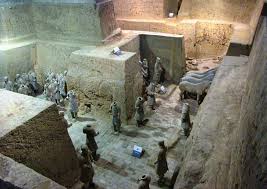
When Will the Mausoleum of the First Qin Emperor be Excavated?
A Legacy Buried in Time
The Mausoleum of the First Qin Emperor, a testament to the ambition and might of ancient China, stands as a captivating enigma. This colossal necropolis, designed by the renowned Chancellor Li Si, consumed the efforts of over 720,000 laborers over a staggering 39 years. Yet, despite the immense time and manpower invested, the mausoleum remained unfinished, its completion thwarted by the fall of the Qin dynasty itself.
A Chance Discovery in a Land of Ancient Secrets
Fast forward to 1974. In the heartland of China, amidst the vast and desolate plains, a farmer embarked on a seemingly mundane task: digging a well. As his shovel delved into the earth, it struck something unexpected - fragments of pottery shards. This seemingly insignificant discovery would soon ignite the archaeological world. Xi'an, the site of this serendipitous find, had long been recognized as a treasure trove of ancient history. Having served as the capital for thirteen dynasties, its soil held the secrets of countless emperors, officials, and civilizations past. The discovery of the Terracotta Army, a mere prelude to the vastness of the Emperor's tomb complex, only served to heighten the allure and mystery surrounding the main burial chamber.
The Dilemma of Excavation: Preservation vs. Discovery
Despite the tantalizing prospect of uncovering the secrets buried within the heart of the mausoleum, the question of excavation remains a complex and controversial one. The reasons for this caution are manifold:
- Structural Integrity: The immense size and complexity of the tomb present formidable engineering challenges. Disturbing the intricate network of chambers and passageways could lead to irreparable damage.
- Technological Limitations: While archaeological techniques have advanced considerably, we still lack the technology to safely and completely excavate a site of this magnitude. The potential for artifacts to be damaged or destroyed is too great a risk.
- Ethical Considerations: The tomb represents the final resting place of a historical figure. The decision to disturb such a site carries significant ethical weight.
Waiting for the Right Time
For now, the Mausoleum of the First Qin Emperor remains an enigma, its secrets lying dormant beneath the earth. Scientists and archaeologists continue to utilize non-invasive techniques, such as ground-penetrating radar and remote sensing, to map the site and unravel its mysteries from afar. The decision to excavate the mausoleum will ultimately depend on advancements in technology, a comprehensive understanding of the tomb's complexities, and a consensus on the ethical implications of such an endeavor. Until then, the silent emperor rests, a testament to the enduring power of time and the mysteries that lie buried within the earth.
FAQs
Q: What is the significance of the Mausoleum of the First Qin Emperor? A: The mausoleum is not merely a tomb, but a microcosm of the emperor's vision of the cosmos. It reflects the power and grandeur of his reign, incorporating elements of his imperial palace and the vastness of his empire.
Q: What treasures are believed to be buried inside? A: Ancient texts describe a simulated celestial realm within the tomb, complete with flowing rivers of mercury and ceilings adorned with precious stones. The emperor's personal belongings, unimaginable riches, and lost historical records are also thought to be entombed within.
Q: Is there a timeline for when the excavation might take place? A: No official timeline has been established. The Chinese government has adopted a cautious approach, prioritizing preservation and waiting for technological advancements that would allow for a safe and complete excavation.